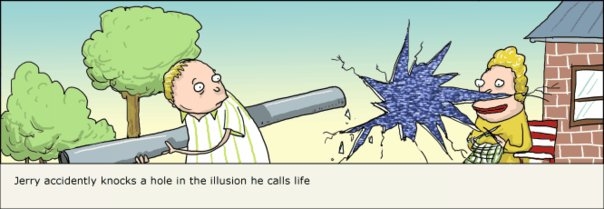August 2009
This Month's Contents: The Cathedral Illustration by William Samuel | A Poem by Heather Saunders | Mirror Therapy by Art Ticknor | Words of Wisdom | Video: A reading of T.S. Eliot's "The Love Song of J. Alfred Prufrock" | Humor |
Enjoy the Forum? You can now own an anthology of some of the best
essays, poems, and humor from 77 issues.
Beyond Mind, Beyond Death
is available at Amazon.com.
Editor's Note
by Shawn Nevins
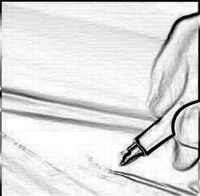 The wasted life. The wish to be forever. Seeing and feeling and the love of
every moment of being. These August themes, weaving through the TAT Forum;
the challenge: touch one inside your self and remember the great unknown just on
the other side of certainty.
The wasted life. The wish to be forever. Seeing and feeling and the love of
every moment of being. These August themes, weaving through the TAT Forum;
the challenge: touch one inside your self and remember the great unknown just on
the other side of certainty.
The Cathedral Illustration
from The Child Within Lives! by William Samuel
Reader, imagine a lovely cathedral, ancient and awesome. You and I sit alone in the middle of it, slanting rays of light from the great windows cutting through the darkness inside. Everything is bathed in mysterious color and silence. Not a sound or motion do we notice anywhere. But if we had the eyes of an eagle or a barn owl, we would see many little church mice scurrying to and fro, scampering silently into and out of the hidden places of the great cathedral. Unseen by us, some mice have discovered the picnic basket we left by the door.
Our illnesses and anguishes are like those church mice. They come into our affairs univited and unwelcome. They eat their fill of our treasured picnic cake and go scampering on their way. Sometimes they do not go on their way, but linger as an ache or pain—or fear—deep in our sense of things. Some of those aches and pains are progressive and terminal, we are told. Those are the most odious church mice of them all.
And there is more. Outside stalk the great rats of starvation and poverty in the world. Another huge rat of violence and war comes and goes from view. Alongside runs a rat pack of disharmony, dissension and distrust joined with those of guilt, age and loneliness. Perhaps as hateful as any are the great rats of confusion and suspicion, fed by the ever-growing, all-encompassing glut of untested information and opinion. The cathedral, the body that sits in it, and the grounds just outside are our own subjective world, you see. It is a subjective world within the Awareness we are.
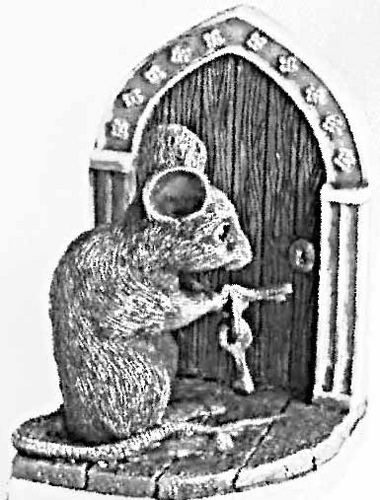 Now, imagine sitting there in that lovely cathedral, unmindful of the church
mice, mind filled with naught but the grand Music of the Spheres, or, mind
filled with thoughts of Godhead and Its allness. Prayer, meditation and
contemplative practices are intended to end our thoughts about the body, the
mice, the cathedral and its gardens, and they do—but, at best, those
activities are temporary palliatives.
Now, imagine sitting there in that lovely cathedral, unmindful of the church
mice, mind filled with naught but the grand Music of the Spheres, or, mind
filled with thoughts of Godhead and Its allness. Prayer, meditation and
contemplative practices are intended to end our thoughts about the body, the
mice, the cathedral and its gardens, and they do—but, at best, those
activities are temporary palliatives.
Now, suppose I ask what Godhead and its allness have to do with church mice and rats? In our metaphysical phase of ongoingness, we proclaim in all earnestness that there are no REAL church mice or rats in all existence. In the perfection of All, there isn't a single real evil. God is all and only, we say. There can't be God and something else, despite the fact that there still appears to be God and all those rats and mice of evil as well—which, of course, other people believe, but we, as enlightened students of Truth, do not.
Ah so. Then what is the ache or pain? "Unreal," you say.
"Yes, it should go away."
"But it persists," you say. "Not enough love in my affairs, not enough understanding, not enough faith. I haven't demonstrated it yet."
Oh? Then there are church mice in the choir loft?
"There just appear to be. They are part of the seeming."
Then you want a part of the SEEMING to go away?
"Oh, yes, I want all of the seeming to go away; I want a healing. I confess I want a healing because I am tired of this appearance. I am physically tired of the constant picture of time's relentless march toward decay. I am tired of growing old and tired of wondering why it is happening even when I know that time isn't real and I have been denying it for so long."
Denying the reality of appearances hasn't done the lease bit of QUANTUM good in the tangible world as far as appearances go. A demonstration here or there, a saint here or there who has done something in a small circle in a small pond, but the world outside continues its acid rain and terrorism. Why, why, why?
Objectivism says the world is full of church mice who need to be told about God. Subjectivism says the church mice do not exist, that they are unreal. Objectivism carried to its extreme has us running all over the cathedral, mesmerized by the mice and accomplishing nothing but a scattering of them. Subjectivism carried to the extreme has us sitting quietly in the middle of the cathedral, meditating, praying, mind-blanking and so God-mindful we never notice the mice. But while we deny their seeming, they seem to go right on eating our tangible picnic. The Zen-like absolutist may disclaim the reality of the mice and perhaps seldom be bothered by them, but at the end of the long day he, too, must stir himself from his reveries, leave the quiet of the cathedral and go outside into the darkness where the rats are larger than the mice. We find that our best efforts at God-mindedness and all our proclamations of the indivisible allness and onlyness of Godhead taken all the way to the limits of absolutism, are not enough to preclude our having to go to the bathroom, feed ourselves or tend to our own appearances of age and debility. One can be a hundred years old and still not know the Answer to the primary question, why the appearances of sin, sickness and death if God is good and God is all.
In those days when time becomes heavy again—or precious—who will say the world's objectivism was any worse than our grand metaphysical subjectivism? Or that subjectivism is further along than (what seems to be) its opposite? Metaphysicians will not like the following observation, but it is objectively true. In the heavy years of age, more anguish is lived in the metaphysical community than in the religious and scientific community. Why? Neither the religionist nor the scientist feels guilty for not knowing enough about God to heal himself.
SOLUTION?
The Balance. The divine Balance. Here is yet another "mystery": Between the two (objective/subjective) is ONE, greater than either separately, and the Source of both....
~ Visit WilliamSamuel.com for more.
A Poem
by Heather Saunders
|
I have this desire to drop everything When I allow, life flows This silent space seems custom made for me Allow outward focus to gently change its course. Childhood patterns become adult patterns I'm terrified of sleepwalking through this entire life |
Mirror Therapy
by Art Ticknor
Walt Whitman traveled to Virginia during the Civil War to look for his brother, who had been wounded at Fredericksburg. He wrote to his mother about the "heap of feet, arms, legs &c." he saw under a tree in front of a hospital tent. He then spent three years attending to wounded soldiers, which led to the "Drum Taps" section of his evolving and growing masterwork Leaves of Grass.
A common phenomenon of the soldiers with amputated limbs was feeling those missing limbs, and frequently the feelings were painful. Silas Weir Mitchell, a Philadelphia doctor who became a friend and correspondent of Whitman's, kept a medical notebook documenting the "sensory ghosts" of the amputees from the battle of Gettysburg, thinking he was the first person to do so. However, as Jonah Lehrer points out in Proust Was a Neuroscientist, a dozen years earlier Herman Melville gave Captain Ahab a sensory ghost of the leg eaten by his nemesis, Moby-Dick. Ahab tells the carpenter who's fashioning an ivory replacement leg, "here is only one distinct leg to the eye, yet two to the soul," and says that he felt tingling life there just as before.
Mitchell felt that the amputees' sensory ghosts supported Whitman's poetry, which stated that matter and spirit were not separate but intertwined. He wrote an anonymous short story, "The Case of George Dedlow" (published in The Atlantic Monthly and available now as a free e-book) giving a first-person fictional account of waking up in a hospital tent with all his limbs missing.
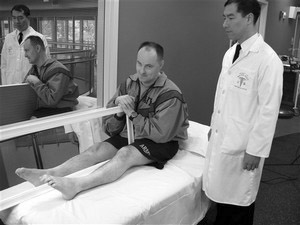 I saw a segment on a TV news program recently showing a treatment for phantom
limb pain that's simple and surprisingly effective. Navy doctor Jack Tsao
prescribed it for artillery sergeant Nicholas Paupore, who was wounded in Iraq.
I saw a segment on a TV news program recently showing a treatment for phantom
limb pain that's simple and surprisingly effective. Navy doctor Jack Tsao
prescribed it for artillery sergeant Nicholas Paupore, who was wounded in Iraq.
Participants in a trial administered by Tsao1 used the mirror therapy technique—simply moving the leg, watching the movement in the mirror and imagining that the missing leg is making the movements—15 minutes a day, five days a week for four weeks. Pain levels came down the first week and continued down. Every person experienced relief, with pain completely disappearing for some. Paupore and some others were able to get off painkillers entirely. "It tricks your brain into thinking your leg is still there, so it's not misfiring," Paupore said. "I don't know how it works, but it works."
Pain is a signal that something's wrong. Seeing their missing legs in the mirror convinced the subconscious mental equipment that they were whole again and relieved the pain associated with the phantom limb.
Consider now, if you would, the existential pain that people suffer. I recall reading somewhere years ago that social outcasts were sometimes banished outside the protection of a city's walls and survived on the city's garbage dump—and I thought, "That's it!" We court the approval of others to fix some perceived lack—some missing limb—and fear the hell2 of social ostracizing.
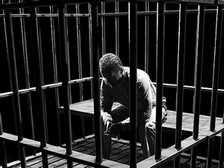 Even worse is the fear of annihilation. We believe we're separate creatures, and
we know the creature's existence is threatened every moment. What will death
bring? We don't know, so we latch onto beliefs and repeat those beliefs as a
mantra whenever the subject of death passes through our awareness: We will
continue on forever in the Happy Hunting Ground, in Paradise, in Heaven … or our
molecules will gracefully disperse back into the cosmic soup … or we will slip
placidly into the comforting oblivion of dreamless sleep. But those beliefs
don't really eliminate the underlying fear; they merely provide distraction,
like sticking our fingers in our ears and singing or talking loudly when we
don't want to hear something someone is saying to us.
Even worse is the fear of annihilation. We believe we're separate creatures, and
we know the creature's existence is threatened every moment. What will death
bring? We don't know, so we latch onto beliefs and repeat those beliefs as a
mantra whenever the subject of death passes through our awareness: We will
continue on forever in the Happy Hunting Ground, in Paradise, in Heaven … or our
molecules will gracefully disperse back into the cosmic soup … or we will slip
placidly into the comforting oblivion of dreamless sleep. But those beliefs
don't really eliminate the underlying fear; they merely provide distraction,
like sticking our fingers in our ears and singing or talking loudly when we
don't want to hear something someone is saying to us.
Can we apply mirror therapy to the existential pain?
We believe ourselves to be individual human beings, irrevocably separate from whatever created us and from other human beings. No matter how close we get with another person, we never approach absolute knowing. And we feel even more not-one with whatever created us.
Our self-beliefs—for example, that the self is a separate entity; is somehow dependent on a body that was born and is going to die; is or has an individual consciousness; is limited, changing, vulnerable, uncertain—cause psychological turmoil and suffering. Like the amputee's phantom limb pain, it is phantom-self pain. Panic attacks (fear of dying or going insane, which reflect the fear of losing the phantom self) and clinical depression (based on the conviction that something that's necessary to our happiness is not possible to attain) are extreme examples.
Have you ever stopped to wonder how it is that we know we're conscious? Our self-consciousness indicates a mirroring effect that's already taking place in the mind. It's as if there's one part of us looking outward and another part of us that's looking backward, aware of the part that's looking outward. But what does that backward-looking part of us see? Nothing … no entity, no Wizard of Oz making things happen … an empty, boundless, changeless, aware non-space.
We have a feeling of what we are. Sure, that's our bike, our car, our toes, and so on, but we feel we're essentially something deeper than those things. We feel that we're what's aware … aware of external things but also of inner things such as thoughts and feelings … and also, somehow, mysteriously self-aware.
We believe mightily that we're a separate, isolated entity attempting to know an unknown self … as if we needed to look into a reflection of our eyes and, in that mirror image, see a reflection back into our "real eye." The hang-up is that we can't conceive of direct seeing without an intermediary. We can't conceive of seeing without a separate seer doing the seeing. We can't conceive of our self as not being a separate seer. How do we get beyond this phantom-seer pain?
Looking for the self, we need to notice what we're looking at (i.e., what we're aware of) and continue looking at it until we see, intuitively, what its relationship is to us. To do this systematically, we begin with more exterior objects—like bikes, cars and toes—and move inward to thoughts, feelings, and beyond. Doing occasional credo exercises to identify our current beliefs about what we are, or what we become identified with, provides us with ongoing material for investigation. All the while, we compare what we're looking at to the feeling of what we really are: that which is aware, which we sense (intuit) from the mirroring aspect of awareness itself.
Letting go of faulty self-beliefs may cause some jolts, but if we persist we will get down to a final faulty self-belief … and a final jolt will leave us with a recognition of direct seeing and absolute knowing.
1Mirror Therapy Shows Promise in Amputee Treatment
2The Old Testament term "hell" is a translation of the Hebrew word Gehennam, which Wikipedia says derives from "Ge Hinnom," meaning "Valley of Hinnom"—the location of the burning garbage dump outside Jerusalem.
Words of Wisdom
|
Video: A reading of T.S. Eliot's "The Love Song of J. Alfred Prufrock"
If you don't see a video clip above, then go directly to YouTube.
Humor.... |

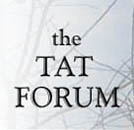
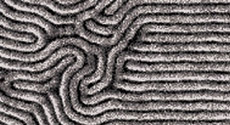 "In Zen, if you put enlightenment first and train according to where
enlightenment leads you, then your days and nights are peaceful. You can't doubt
this. Trying to obtain enlightenment by first exhausting one's attachments
sounds natural, but in reality obtaining enlightenment this way is difficult.
Exhausting one's karma by putting enlightenment first is a simple and
straightforward thing."
"In Zen, if you put enlightenment first and train according to where
enlightenment leads you, then your days and nights are peaceful. You can't doubt
this. Trying to obtain enlightenment by first exhausting one's attachments
sounds natural, but in reality obtaining enlightenment this way is difficult.
Exhausting one's karma by putting enlightenment first is a simple and
straightforward thing."